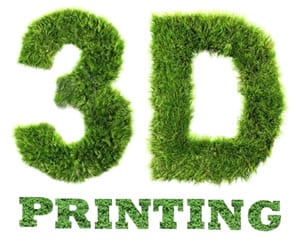It is no secret that 3D printing, also called AM (Additive Manufacturing), has revolutionized the manufacturing industry because 3D printing provides several advantages and benefits over conventional manufacturing methods. A brief list highlights what some of these benefits are:
- 3D printing can produce a large variety of manufactured products, including customizable products and even an individual’s personal designs.
- 3D-printed products can more quickly go from a design to an actual prototype, reducing tooling and labor costs.
- With traditional manufacturing technologies, it is more cost-effective to anticipate the need for additional products and to manufacture and warehouse them. With 3D printing, only products that are sold need to be manufactured. Because products can be produced on demand, warehousing of excess inventory and shipping costs are significantly reduced.
- As 3D printing technology advances, it is likely that printing of body organs and prostheses will lengthen and improve the quality of life.
- 3D printing can manufacture complex shapes which will be difficult, if not impossible to manufacture with traditional methods.
- 3D printing is eco-friendly because it uses less raw material. Traditional manufacturing methods (subtractive manufacturing) waste about 30% of the raw material, while 3D printing uses about 98% of the raw material. Presumably, less wastage of raw materials suggests that 3D printing is environmentally friendly. This assumption remains to be proven.
- With regard to 3D printing of plastic-based objects, the technology uses less energy. With 3D printing of metal or ceramic-based parts, it is questionable whether this claim is true.
Some of the advantages listed have to do with (a) reduced industrial waste, (b) less energy usage, and (c) reduced carbon emissions. Recent studies indicate that these environmentally-related advantages may not be accurate, and that they need to be examined more carefully.
In this article, we attempt to answer these questions:
- Does 3D printing use less energy than traditional manufacturing methods?
- Is 3D printing eco-friendly?
Does 3D Printing Use Less Energy Than Traditional Manufacturing Methods?
A study performed in 2008 (The Atkins Project) determined that 3D printers that use heat or a laser to melt plastic consumed up to 100 times more electrical energy than traditional mass manufacturing to make an object of the same weight. Because 3D printing uses thermal processes or powerful lights to cure resins, the technology consumes a lot of energy. When compared with injection molding which can produce 1,000 parts an hour, 3D printing which uses the same amount of energy will produce about 100 parts per hour.
Another study performed by MIT’s Environmentally Benign Manufacturing in 2009 determined that laser direct metal deposition (where metal powder is fused together) used hundreds of times the electricity as traditional casting or machining. This means that with regard to energy usage, 3D printers are better for small batch runs, but not for large-volume industrially-sized 3D printing.
Another study performed at Michigan Technology University determined that. 3D printing of plastic-based objects could save between 41% to 64% in energy costs, compared with the traditional injection molding method. The study did a Life Cycle Analysis of three products: a citrus juicer, a children’s building block, and a water spout. This result, when compared with the previous two results, confirms that 3D printing is energy efficient for small volume manufacturing of plastic-based products. However, 3D printing is not energy efficient for large volume manufacturing, especially if the manufactured product is not plastic-based.
It appears that 3D printing is eco-friendly with regard to energy usage for home-based or small volume manufacturing of plastic-based objects, but not for large volume manufacturing.
Is 3D Printing Eco-Friendly?
Although 3D printing is eco-friendly because it uses less energy usage under certain conditions, reduced energy usage is not the only criterion for determining whether the technology is eco-frendly. Another criterion, which may be more important than energy usage, is the amount of carbon footprint or carbon emissions that 3D printing generates. It is a known fact that the earth’s atmosphere is well past stable levels of carbon dioxide. Therefore, it is necessary to monitor new technologies which could adversely affect the environment. Several studies have been undertaken to determine the extent of carbon emissions or the carbon footprint of 3D printing.
Recent research has determined that 3D printing may not be environmentally friendly, because most of the raw materials used in 3D printing are photopolymers. The problem with photopolymers is that when they are made, the induced chemical reactions produce a toxic heavy metal called antimony, and printed items based on photopolymers can contain up to 100 times the levels of antimony found in other polymers such as polyethylene terephthalate which is often used for food packaging.
Another problem with plastic-based 3D printing is that a significant amount of waste is generated in the form of powdered or molten polymers. Furthermore, printing fumes are generated when plastic is heated to high temperatures. These fumes are toxic and are health hazards. Although the level of toxicity created by 3D printing is not very high, it could lead to lung function damage in the form of airway inflammation, allergic responses, and altered heart rate variability. As a precaution, it is advisable to have an open window and a re-circulating fan near a 3D printer which runs for an extended period of time. The good news is that research is ongoing to use biodegradable materials such as PLA, which is a corn-based plastic.
Conclusions
According to the saying “There is no free lunch”, it is clear that although 3D printing provides many advantages and benefits in comparison with traditional manufacturing methods, much more work remains to be done to make the technology environmentally friendly. The problems that should be solved in order to make 3D printing into a green technology are indeed challenging, but they do not seem to be insurmountable. It is not presumptuous to say that 3D printing will become a mature, safe, beneficial, and cost effective manufacturing technology in the future.

